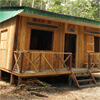Imperiled Birds to Benefit from Land Purchase in Key Peruvian National Reserve
 The Black-headed Parrot is one of hundreds of species that will benefit from this project in Allpahuayo Mishana National Reserve. Photo by D. Lebbin/ABC. |
 | |
(Washington, D.C., November 30, 2012) The critically endangered Iquitos Gnatcatcher, and the vulnerable Allpahuayo Antbird and Mishana Tyrannulet are three of the bird species that will benefit from the purchase of more than 1,100 acres of private inholdings within Peru's Allpahuayo Mishana National Reserve by ProNaturaleza (a leading Peruvian conservation organization) in collaboration with American Bird Conservancy (ABC).
SERNANP – the Peruvian agency in charge of protected areas – has now published three resolutions accepting the donation of 55 pieces of land totalling more than 2,370 acres (including 1,270 acres previously purchased by ProNaturaleza and ABC) as part of the Allpahuayo Mishana National Reserve. The reserve, which is located only 15 miles from the city of Iquitos in northern Peru, contains rare white-sand forests called varillales and is home to 20 species of neotropical migrant birds as well as a variety of rare and unique plants and animals.
“Allpahuayo Mishana is an incredibly special place. It regularly offers up important new conservation surprises that highlight the need to consolidate protection in and around the reserve. For example, five new bird species have been described from this area, with one more potentially waiting description” said Martin Alcalde, Director of ProNaturaleza.
The protected area was first declared as a Reserve Zone in 1999, and elevated to a National Reserve in 2004. At that time, much of the land within its boundaries remained under private ownership. Continued timber extraction, charcoal production, and land clearance for agriculture on these lands damage the reserve's forests and reduce habitat for its threatened wildlife.
Aside from land purchases, ProNaturaleza and ABC are working to improve management of the reserve. The project has assisted SERNANP in updating the reserve's management plan and constructing a new guard post in December 2011. Additional guard training and educational programs for local school children have been conducted.
“ProNaturaleza and ABC efforts have significantly improved our capacity to manage the Allapahuayo Mishana National Reserve and their involvement is greatly appreciated” said Carlos Rivera, the director of Allpahuayo Mishana National Reserve.
In March 2012, interpretive signs were erected in the popular Quistococha Zoo near Iquitos that promote birdwatching, show Iquitos residents the importance of Allpahuayo Mishana National Reserve, as well as urging them to avoid purchasing the meat of the endangered Wattled Curassow that they may find in local markets.
“A total of 496 bird species have been recorded in the reserve, more than are found in several much larger protected areas in the Amazon of northern Peru. Allpahuayo Mishana protects a diversity of vegetation formations, including black-water flooded forests and white sand forests poorly represented in other reserves. Notably, twenty-three bird species are tightly associated with white-sand forest habitats within the reserve.” said Dr. Daniel Lebbin, Conservation Biologist at ABC. The reserve is also home to two rare primates: the Yellow-handed Titi Monkey and Equatorial Saki.
To achieve these successes, ProNaturaleza worked in cooperation with a coalition including SERNANP, the Quistococha Zoo, Friends of Allpahuayo Mishana, and CANATURA (a group conducting environmental education), local communities and other stakeholders. Financing for this work was graciously provided to ABC and ProNaturaleza by the National Fish and Wildlife Foundation and the Robert W. Wilson Charitable Trust.





















































